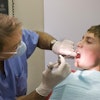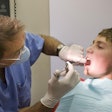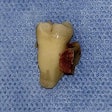Patients given ester-based local anesthetics may be at greater risk of having serious complications when they are administered numbing agents, according to a study published on March 31 in the International Dental Journal.
A lower risk of severe negative outcomes may be linked to amide-based anesthetics like lidocaine and articaine, the authors wrote.
"These findings underscore the importance of combining pharmacovigilance data with clinical practice insights to enhance patient safety and optimize anaesthetic selection," wrote the authors, led by Ferit Bayram, of Marmara University in Istanbul.
Though anesthetics are needed to facilitate safe and effective dental procedures, possible negative outcomes, including hospitalizations and even death, continue to be a serious concern for clinicians.
To explore complications related to anesthetics, adverse event reports from the U.S. Food and Drug Administration Adverse Event Reporting System database were analyzed. Negative outcomes were described using patient demographics and clinical characteristics, and ester and amide anesthetic-linked complications were compared based on severity.
The analysis revealed 1,956 dental cases associated with anesthesia-related adverse events. Of these cases, a significantly higher risk of serious adverse reactions was linked to ester-based anesthetics (odds ratio [OR]: 3.86, 95% confidence interval [CI]: 2.77 to 5.39) and a lower risk of negative outcomes with amide-based local anesthetics (OR: 0.24, 95% CI: 0.17 to 0.33), the authors wrote.
Ester-based agents like benzocaine were linked to a considerably higher risk of serious adverse events (OR: 7.85, 95% CI: 4.81 to 12.91). However, amide-based agents like lidocaine (OR: 0.59, 95% CI: 0.48 to 0.71) and articaine (OR: 0.63, 95% CI: 0.52 to 0.76) were associated with a lower risk of negative outcomes, they wrote.
Additionally, the risk of hospitalization, life-threatening events, and death were significantly higher with ester-type local anesthetics, benzocaine, and combined anesthetics.
Most importantly, the hospitalization risk was greater with benzocaine (OR: 2.96; 95% CI: 1.99 to 4.39) and overall ester-based anesthetics (OR: 2.19; 95% CI: 1.54 to 3.11). Meanwhile, amide-type anesthetics were linked with a significantly lower risk of hospitalization (OR: 0.46, 95% CI: 0.32 to 0.65), the authors wrote.
In terms of life-threatening events, benzocaine showed a strong association (OR: 2.94, 95% CI: 1.98 to 4.36), while amide-based anesthetics like lidocaine (OR: 0.80, 95% CI: 0.55 to 1.15) and articaine (OR: 0.55, 95% CI: 0.37 to 0.82) had a lower risk.
Finally, the risk of death was dramatically greater in those given benzocaine (OR: 2.56, 95% CI: 1.12 to 6.12) and overall ester local anesthetics (OR: 2.66, 95% CI: 1.25 to 5.71). However, articaine had a notably lower risk (OR: 0.35, 95% CI: 0.16 to 0.81), they wrote.
Nevertheless, the study had limitations, including voluntary reporting. This introduces bias and underreporting, the authors wrote. In the future, more studies with larger case series and prospective cohort designs should be completed to validate these results, they wrote.
"Ester-based preparations appear to have increased risk of serious AEs (adverse events), confirming the lower odds with lidocaine and articaine, the predominant LAs (local anesthetics)," Bayram and colleagues wrote.




















